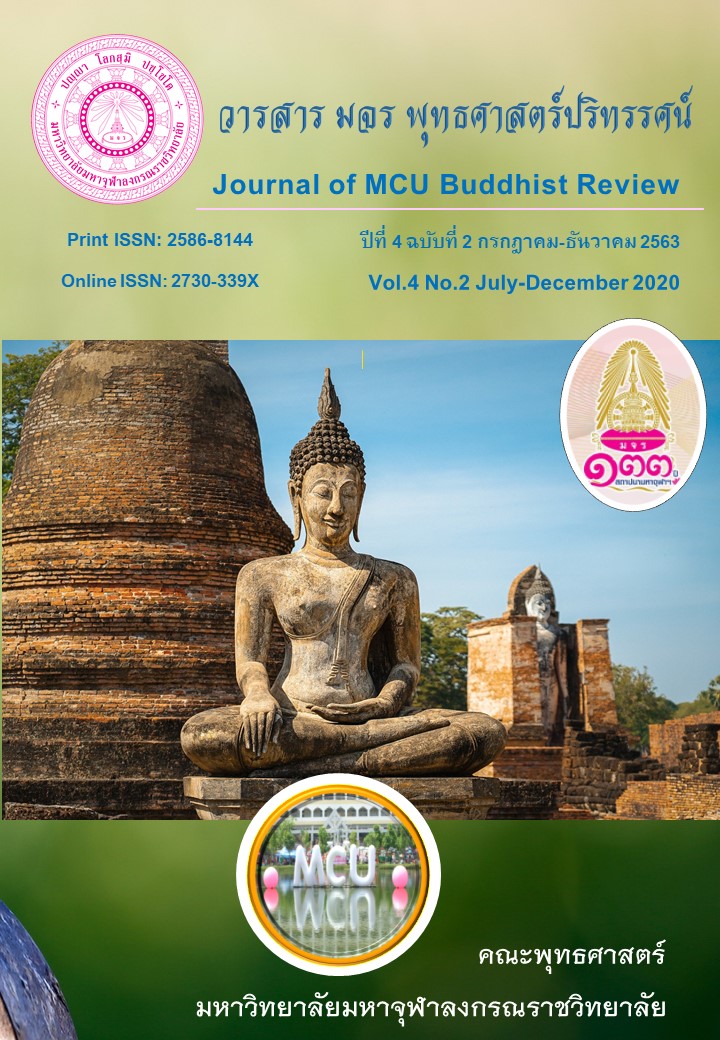พุทธประวัติตอนออกผนวช: การตีความตามคัมภีร์เนตติปกรณ์
Main Article Content
บทคัดย่อ
บทความชิ้นนี้มีจุดมุ่งหมายที่จะวิเคราะห์ถึงเรื่องราวพุทธประวัติตอนออกผนวช โดยได้ใช้การวิเคราะห์ตีความตามคัมภีร์เนตติปกรณ์ ด้วยหลักเทศนาหาระ 6 อย่าง ได้แก่ อัสสาทะ อาทีนวะ นิสสรณะ ผละ อุปายะ และอาณัตติ มาช่วยในการทำความเข้าใจพุทธประวัติในช่วงนี้ ผลการศึกษาสามารถสรุปได้ว่า อัสสาทะของการออกบวชของเจ้าชายสิทธัตถะ ทำให้พระองค์สามารถประพฤติพรหมจรรย์ได้อย่างเต็มที่ อาทีนวะของการออกบวชของพระองค์โดยไม่ได้บอกกล่าวขออนุญาต ทำให้เครือญาติเกิดความเศร้าเสียใจและเป็นทุกข์ จนนำมาสู่การบัญญัติเป็นพระวินัยสงฆ์ที่ก่อนจะบวชพระหรือเณร พระอุปัชฌาย์จะต้องสอบถามผู้ที่จะบวชให้ดี ถ้าหากไม่ได้รับอนุญาตมาแล้วบวชให้จะต้องอาบัติทุกกฎ นิสสรณะของการออกบวชของพระองค์ มีหนทางแห่งการดับทุกข์ ที่เรียกว่า อริยมรรคมีองค์ 8 เป็นแนวทางดำเนิน ผละของการออกบวช คือ พระองค์ได้ตรัสรู้เป็นพระสัมมาสัมพุทธเจ้า ดับกิเลสได้โดยสิ้นเชิง พ้นจากความทุกข์ ยังประโยชน์แก่พระองค์เอง และเวไนยสัตว์ทั้งหลาย อุปายะของการออกบวช คือ การดำเนินตามทางของอริยมรรคไปสู่พระนิพพาน ซึ่งสรุปรวมเรียกว่า ไตรสิกขา คือ ศีล สมาธิ และปัญญญา และอาณัตติของการออกบวชของเจ้าชายสิทธัตถะ คือ พระองค์ได้แนะนำ ชักชวนผู้อื่นให้รู้ตาม และปฏิบัติตามพระองค์ด้วย คือ ปัญจวัคคีย์ เป็นกลุ่มแรก ด้วยการแสดงปฐมเทศนา “ธัมมจักกัปปวัตตนสูตร”
Article Details
- บทความที่ได้รับการตีพิมพ์เป็นลิขสิทธิ์ของวารสาร มจร พุทธศาสตร์ปริทรรศน์
- ข้อความใดๆ ที่ปรากฎในบทความที่ได้รับการตีพิมพ์ในวารสาร ถือเป็นความรับผิดชอบของผู้เขียนบทความ และข้อคิดเห็นนั้นไม่ถือว่าเป็นทัศนะและความรับผิดชอบของกองบรรณาธิการวารสาร มจร พุทธศาสตร์ปริทรรศน์
เอกสารอ้างอิง
นงค์พงา เจริญสุขมงคล. (2551). สิทธิสตรีไทยภายใต้พันธกรณีระหว่างประเทศด้านสิทธิมนุษยชน : สิทธิการบวชในพระพุทธศาสนา. วิทยานิพนธ์นิติศาสตรมหาบัณฑิต. คณะนิติศาสตร์ มหาวิทยาลัยธรรมศาสตร์.
พระธรรมกิตติวงศ์ (ทองดี สุรเตโช). (2552). การตีความพุทธศาสนสุภาษิต. พิมพ์ครั้งที่ 5. กรุงเทพมหานคร: สำนักพิมพ์เลี่ยงเชียง.
พระธรรมปิฎก (ป.อ.ปยุตฺโต). (2557). สอนนาค-สอนฑิต:ชีวิตพระ – ชีวิตชาวพุทธ. นครปฐม:วัดญาณเวศกวัน.
พระพรหมคุณาภรณ์ (ป.อ. ปยุตฺโต).(2551). พจนานุกรมพุทธศาสตร์ ฉบับประมวลศัพท์. พิมพ์ครั้งที่ 11.กรุงเทพมหานคร: มหาจุฬาลงกรณราชวิทยาลัย.
พระมหากมล ถาวโร (มั่งคำมี). (2543). “สถานภาพสตรีในพระพุทธศาสนา”. วิทยานิพนธ์พุทธศาสตรมหาบัณฑิต,(บัณฑิตวิทยาลัย:มหาวิทยาลัยมหาจุฬาลงกรณราชวิทยาลัย.
พระอุดรคณาธิการ (ชวินทร์ สระคำ). (2538). พจนานุกรมบาลี-ไทย ฉบับนักศึกษา. กรุงเทพมหานคร : บริษัทประยูรวงศ์ ปริ้นติ้ง จำกัด.
พุทธทาสภิกขุ. (2537). คําสอนผู้บวช ภาค 1. กรุงเทพมหานคร:สมชายการพิมพ์.
สมเด็จพระมหาสมณเจ้า กรมพระปรมานุชิตชิโนรส. (2554). สมุดภาพปฐมสมโพธิกถา : วรรณคดีพระพุทธศาสนาพากษ์ไทย คัมภีร์แสดงเรื่องราวของพระพุทธเจ้า.กรุงเทพมหานคร: สำนักพิมพ์ธรรมสภา.
สมเด็จพระญาณสังวร (เจริญ สุวฑฺฒโน). (2551). 45 พรรษาของพระพุทธเจ้า. พิมพ์ครั้งที่ 5.กรุงเทพมหานคร: มหามกุฏราชวิทยาลัย.


